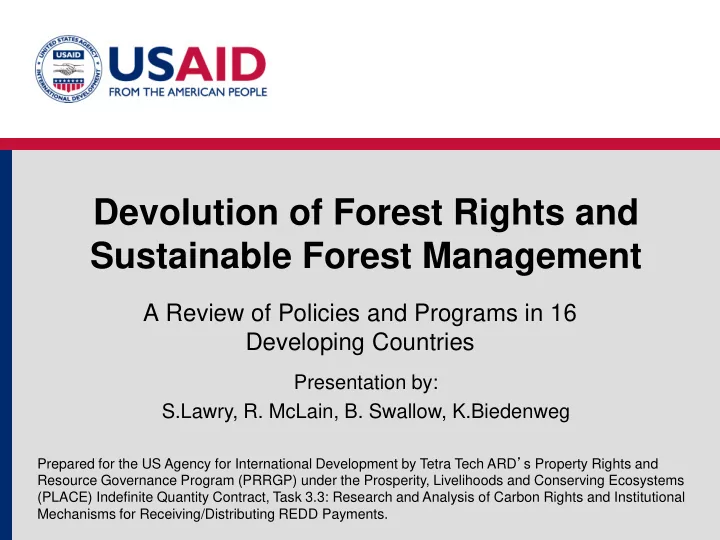

Devolution of Forest Rights and Sustainable Forest Management A Review of Policies and Programs in 16 Developing Countries Presentation by: S.Lawry, R. McLain, B. Swallow, K.Biedenweg Prepared for the US Agency for International Development by Tetra Tech ARD ’ s Property Rights and Resource Governance Program (PRRGP) under the Prosperity, Livelihoods and Conserving Ecosystems (PLACE) Indefinite Quantity Contract, Task 3.3: Research and Analysis of Carbon Rights and Institutional Mechanisms for Receiving/Distributing REDD Payments.
Global Forest Tenure Transition* 80 76 % Area by Tenure Type 70 65 • Failed government control 60 • Devolution/decentralization 2002 50 Reduced timber rents • 2008 Democratization pressures 40 • International human rights 30 18 20 15 13 10 6 4 3 0 Public - Government Public - Reserved for Private - Community Private - Administered Communities and Ownership Individuals/Firms Indigenous Peoples *Source: RRI/ITTO. 2010. Tropical Forest Tenure Assessment. (Data for 30 countries).
Objective: To explore and analyze the general patterns of the global forest tenure transition within countries and regions. Guiding Questions: • What forest governance devolution approaches have been tried? (which rights have been devolved) • How successful have they been relative to improvements in ecological and livelihood outcomes? • What are the implications for efforts to conserve forests (including investments linked to REDD+)?
Methods • Literature review and comparative case analysis • 16 case study countries Latin America Africa Asia Bolivia Dem. Rep. of Congo India Brazil Ethiopia Indonesia Guatemala Ghana Nepal Mexico Kenya Philippines Peru Tanzania Vietnam Zambia Selection considerations : Size of forest, experience with devolution, potential for USAID investment
Analytical Framework Click and add insert graphic here (5 ” high x 8.5 ” wide maximum).
Approaches to Forest Governance Devolution Click and add insert graphic here (5 ” high x 8.5 ” wide maximum).
Regional Overviews
The Forest Tenure Transition in Latin America Percent Area by Tenure Type Source: RRI/ITTO. 2010. (8 countries; 82% of Latin America ’ s tropical forests
Key Features of Forest Reform in Latin America • Titles require retention of forest cover • Forestlands are demarcated and titled as collective or communal properties; States retain alienation rights • Emphasis has been on transferring rights to indigenous and ethnic communities • Reforms are aimed at addressing conservation, livelihood, and rights-based goals simultaneously • Reforms are driven from above and below • Considerable diversity in tenure models: – indigenous territories, extractive reserves, agro-extractive and forestry settlements, community concessions
The Forest Tenure Transition in Africa* Public - Government 2002 2008 Administered 0.1 1% 1% 0% 0 0 Public - Reserved for Communities and Indigenous Peoples Private - Community Ownership Private - Individuals/Firms 99.9 98% Percent Area by Tenure Type *Source: RRI/ITTO. 2010. Tropical Forest Tenure Assessment. (Data for 8 countries, representing 84% of African tropical forests).
Benefit-Sharing Arrangements Fall Short • Tend to give insufficient attention to reaching agreement with local beneficiaries on benefit-sharing formula early in the process • Because they are administrative rather than rights- devolution models, government agencies can withdraw or adjust benefits at their discretion • Benefit-sharing schemes are often expensive to administer and generate high transaction costs for government agencies and village participants alike • Existing benefit-sharing arrangements must be assessed for administrative efficiency and delivery of meaningful benefits to individuals and communities
The Forest Tenure Transition in Asia Percent Area by Tenure Type Source: RRI/ITTO. 2010. (8 countries; 90% of Asian tropical forests)
Lessons from Forest Governance Devolution in Asia • Formal recognition of strong bundle of rights makes a difference (generally positive impacts on ecological conditions; impacts on livelihood outcomes have been mixed) • Build on local institutions but recognize their weaknesses (chronic issues with elite capture, underrepresentation of women and ethnic minorities) • Recognize the limits of benefit-sharing arrangements (chronic issues with forestry officials dominating, onerous management plans and inventory requirements, corruption of officials) • Having a right in law isn ’ t enough; safeguards are needed to ensure rights can be exercised (Ex: 2006 India ’ s Forest Rights Act)
Conclusion and Recommendations
Conclusion and Recommendations Tenure security over forests is theoretically and empirically strongly associated with improvements in forest condition and livelihoods. Promote rights devolution as a key element in any policy to improve forest conditions and improve local livelihoods. Effective community ownership models can take a variety of forms: for instance concessions, community forest reserves, and customary tenure. Tenure arrangements that best align with local custom and conventions and administrative capacities should be given priority.
Conclusion and Recommendations There will be winners and losers in any rights-based forest reform. Take care to account for and ameliorate potential negative consequences. Poor execution in forest rights reforms can be addressed through support for land rights and forest sector institutional reforms, including training, capacity building, accountability reforms, fostering stronger relationships with civil society organizations. As a research priority, support case study research and systematic comparative reviews of governance variables affecting implementation of forest reform initiatives — Execution, accountability, monitoring, restructuring of forest agencies.
Recommend
More recommend